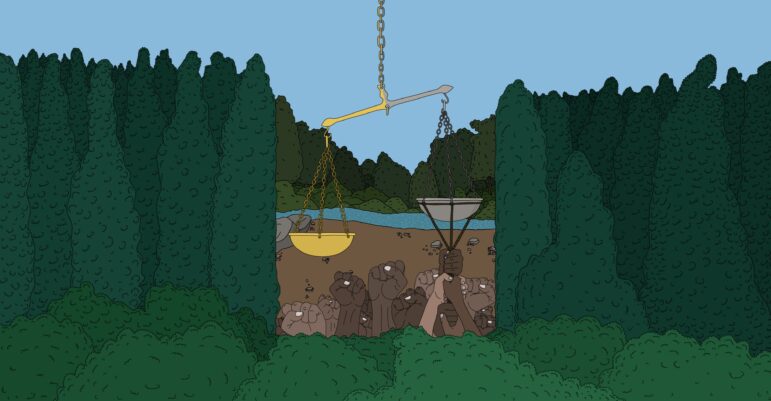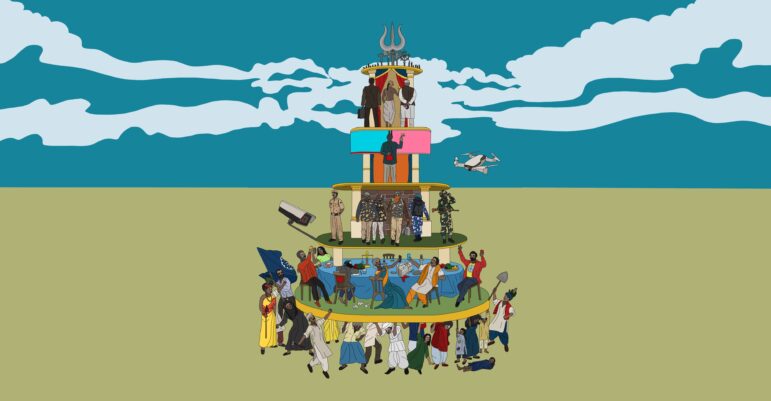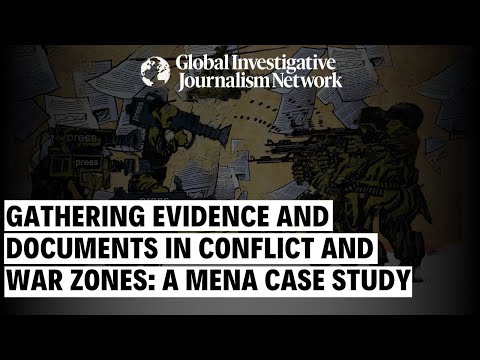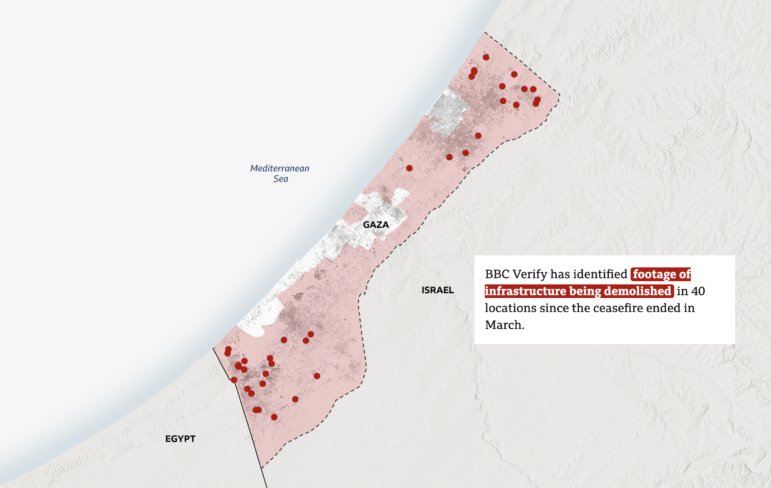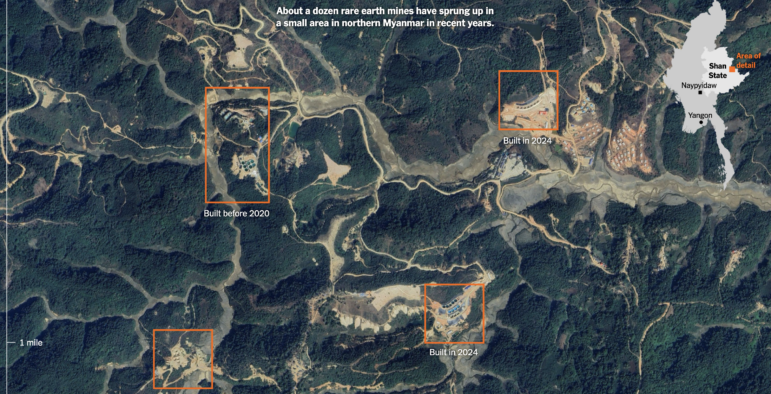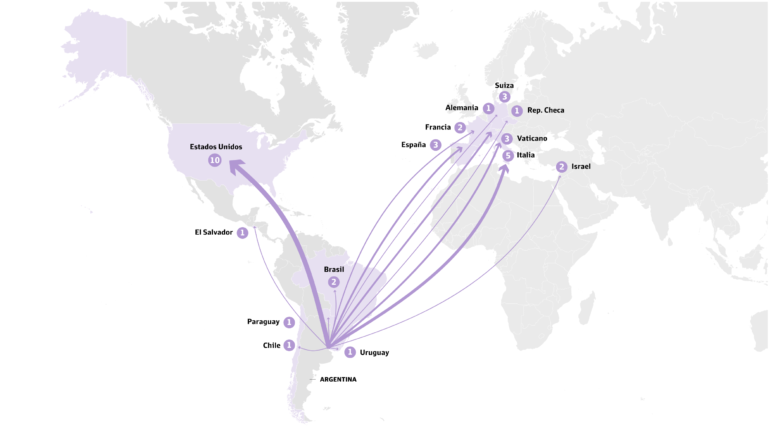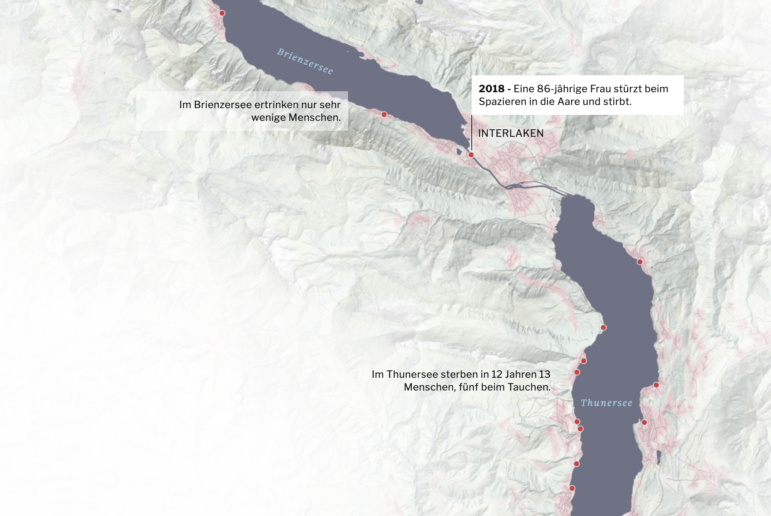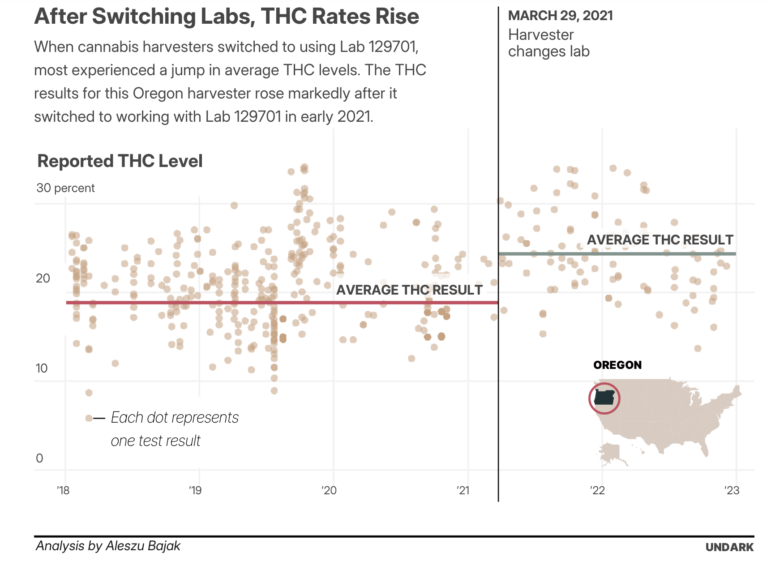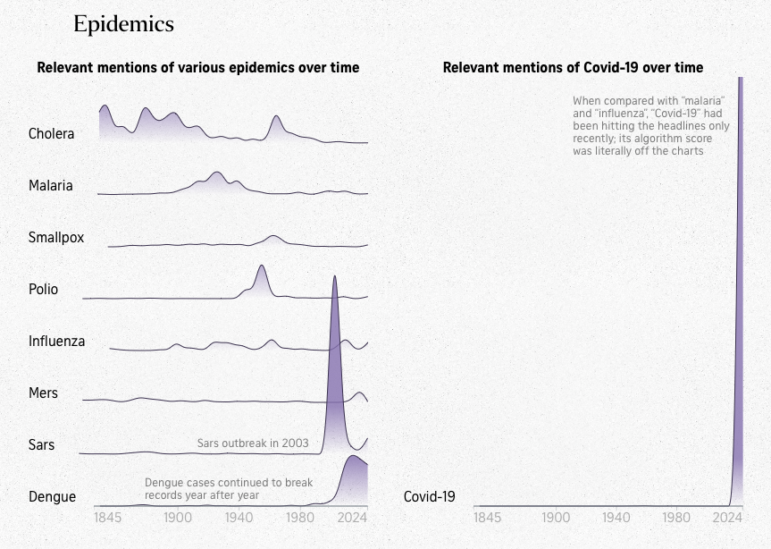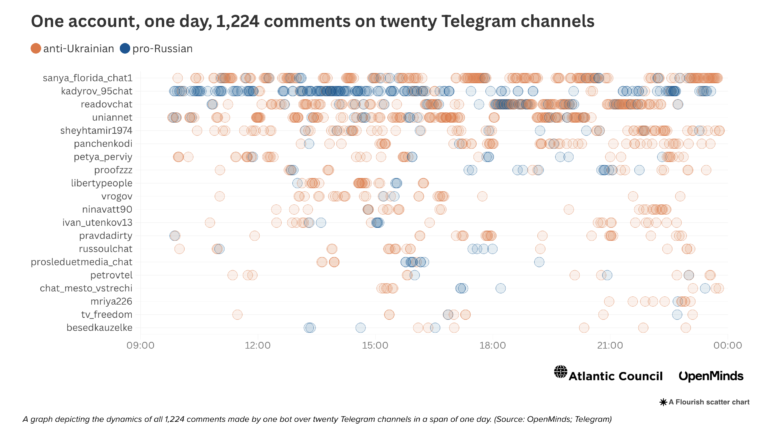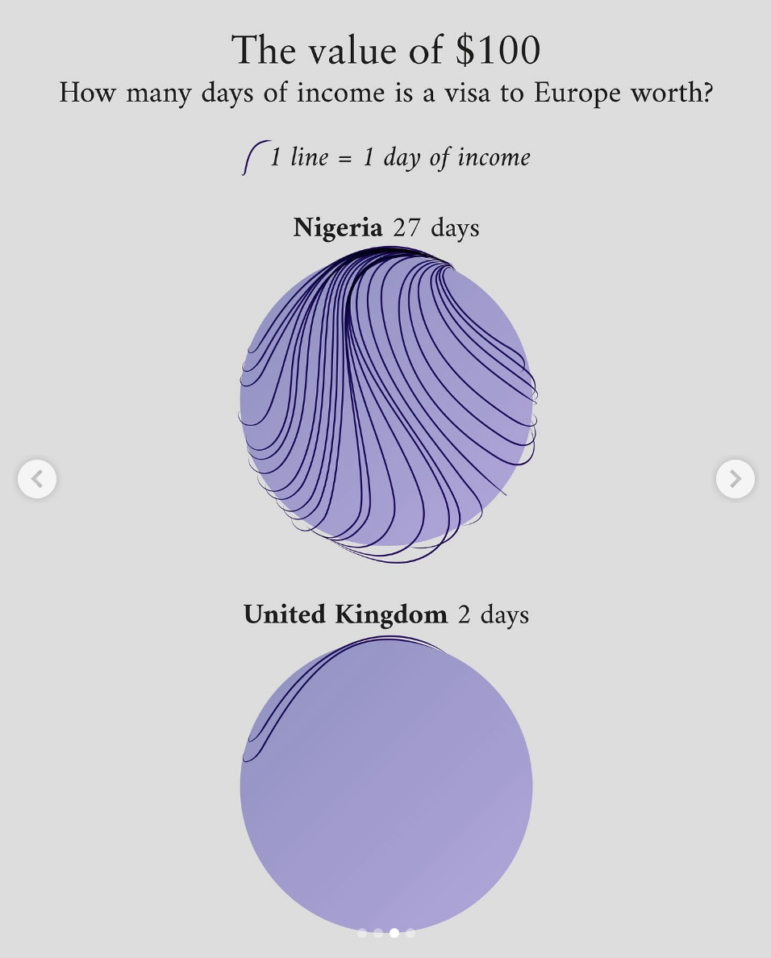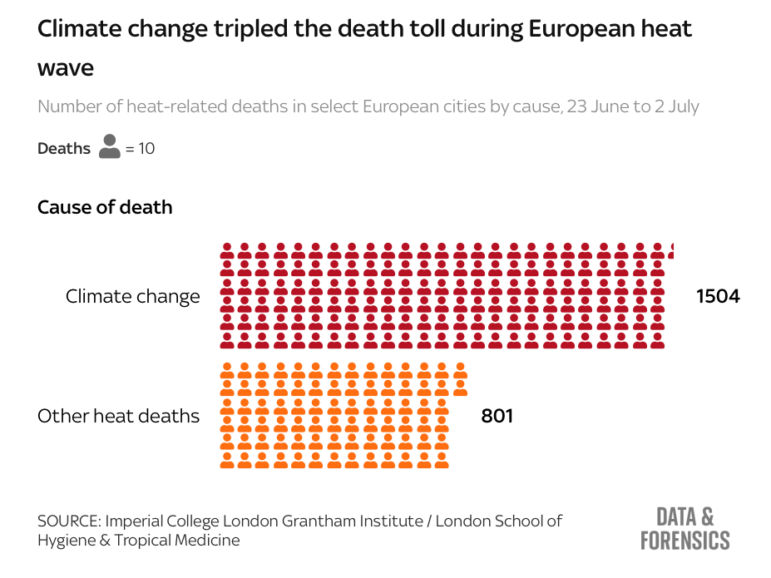

BBC Verify time lapse image of the Israeli razing of Qizan Abu Rashwan, a Gaza agricultural settlement about four miles from the Israeli border. Image: Screenshot, BBC Verify, Planet Labs
Israeli War on Gaza Infrastructure, Trump Tariff Economic Hit, Myanmar Mining Pollution, Runaway Global Arms Race
US tariffs have caused global markets to shift and trade ministers to break a sweat this year, with President Donald Trump’s frequent threats and shifting stances creating financial uncertainty across the world. Now, the financial toll is becoming clear. In a detailed data analysis of over 200 companies, Reuters assessed the impact of these escalating trade levies, revealing the growing strain on businesses. In this edition of our Data Journalism Top 10, covering stories from July 10 to 23, we also share a compelling investigation by BBC Verify, which uses open source tools to uncover evidence of controlled demolitions of civilian buildings in the Gaza Strip, while La Nación maps Argentinian President Javier Milei’s extensive travels since taking office. Meanwhile, Switzerland’s Tages-Anzeiger presents a sobering, data-driven look at drowning fatalities along the country’s second-longest river.
Israel’s Razing of Gaza’s Civilian Infrastructure
Vast swathes of the besieged Gaza Strip have been designated by Israeli forces as “militarized” zones, with civilians who live there put under evacuation orders. But a closer examination of the so-called “operational control” areas in this BBC investigation suggests that Israel is systematically demolishing civilian infrastructure and buildings through controlled detonations — even though the Geneva Convention “largely prohibits the destruction of infrastructure by an occupying power.” Since the collapse of a ceasefire deal with Hamas in March, BBC Verify has identified at least 40 such demolition sites — including places where “controlled explosions, excavators, and bulldozers have obliterated whole areas.” Through geolocation and satellite image comparison, the reporters documented the destruction of infrastructure that had previously withstood Israeli bombardments. Using interactive mapping and verified footage, the reporting showed Israeli tanks and bulldozers advancing through streets near the border with Egypt, as well as deep within Gaza, where Israeli forces have carved out expansive “security zones” and corridors. These divisions bisect the territory, with numerous buildings razed along and near these routes. (The Israel Defense Forces told the BBC it was operating in accordance with international law.)
How Companies are Responding to Trump’s Tariffs
A series of steep US tariffs are poised to take effect on August 1, unless affected countries can broker a trade deal with Washington, and industries ranging from automotive to consumer to technology are already feeling the impact of levies. Reuters has tracked how 288 companies across the globe have responded to Trump’s tariffs so far. Journalists compiled data from corporate earnings reports, regulatory filings, and company statements since April 2 — when global tariffs were first announced — to create an interactive database on company reactions. From profits warnings to job cuts, it estimates that tariffs have had an impact exceeding US$34 billion as of May. While not an exhaustive list, the analysis hints at how far-reaching Trump’s tariff policies could be going forward.
Wartime Mining Boom in Myanmar
Rare earth elements power green tech, but mining them is often destructive. In Myanmar, the country’s protracted civil war is fuelling their illicit trade, with Chinese crime syndicates accused of driving regional instability. According to this New York Times investigation, rare earth mining is polluting rivers, including the Kok and Mekong, where arsenic and other pollutants have reached hazardous levels. Using satellite imagery analysis, the team located where rare earth mineral mines have emerged along the Kok River and mapped the flow of contaminated water into neighboring Thailand, where residents in local villages are facing serious health issues. According to the investigation, Thai officials have yet to comprehensively test the water, despite fears it could also contain a radioactive byproduct of this type of mining.
Javier Milei’s Presidential Trips
According to La Nación, it’s a mileage that would make even Jules Verne’s Phileas Fogg “envious:” In roughly 18 months, Argentinian President Javier Milei has made 24 official trips covering more than 221,800 kilometers (138,000 miles), at an estimated cost of US$3.6 million according to figures by the Chief of Staff’s Office to Congress. La Nación analyzed Milei’s first 573 days in office and calculated how much time he has spent abroad versus travel days within Argentina, mapping each international visit as well as tabulating which cities he visited when. His favourite destination? The US. La Nación also visualized who has accompanied him most frequently on his trips and reveals a striking fact: while he spent 80 days of his administration abroad, he has spent only 26 days in the Argentinian provinces.
Tracking the Global Arms Race
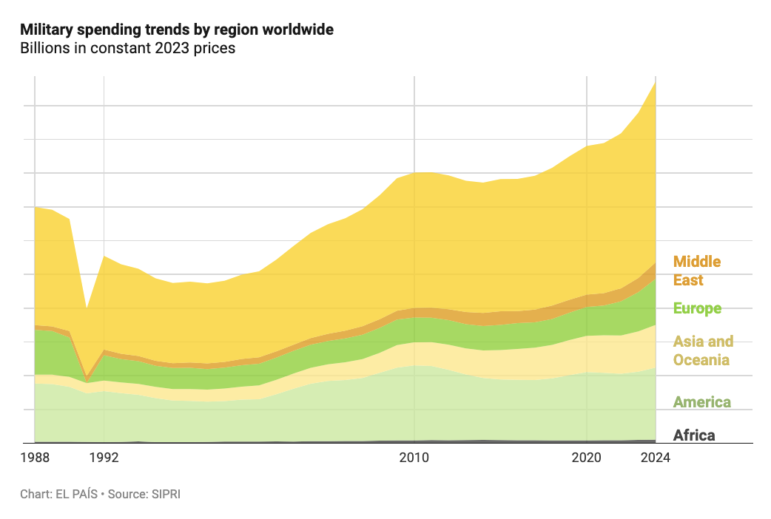
Tracking military spending by continent/region, global total in yellow (top). Image: Screenshot, El País
Wars in Europe and the Middle East, as well as other regional conflicts, are driving up military spending worldwide. Using data collected by the Stockholm International Peace Research Institute (SIPRI), as well as arms exports data, Spanish daily newspaper El País charted the state of defense spending and the biggest benefactors — arms companies. In 2024, global military spending reached US$2.7 trillion, an increase of 9% compared to the previous year and the highest since the end of the Cold War. Reporters created 11 charts to explore what is happening: charting military spending trends by region, ranking the world’s largest arms companies, and analyzing the top arms-importing countries worldwide.
Drownings in the Swiss River Aare
The 180-mile-long Aare is Switzerland’s second-longest river after the Rhine. But while it is a popular spot for swimming and water sports, it is the country’s most deadly for water deaths: 71 out of 600 drownings that have occurred in the country in the last 12 years were in the Aare. Using new data from the Swiss Lifeguard (Die Schweizerische Lebensrettungs-Gesellschaft, or SLRG, Tages-Anzeiger took readers along the Aare, mapping each fatal incident since 2012. The team obtained data across multiple years and water types, in addition to age and gender breakdowns, and a time‑series and geographic trend analysis to identify hotspots where disproportionately high drowning incidences occur.
Investigating the US Cannabis Industry
Although marijuana is still banned at the federal level, most US states have now legalized its use for some purposes. This has sparked a “green rush,” with producers trying to cash in on the $47 billion industry. Colorado-based investigative journalist Teresa Carr explored the underreported health risks tied to medical marijuana in an Undark investigation that uncovered some cannabis products that are contaminated with toxic mold and pesticides. Whistleblower reports and open records requests for cannabis testing data across multiple states also revealed a widespread and deeply rooted problem: some producers are “lab shopping” — submitting samples to multiple labs and picking the one with the most favorable results, often with inflated THC levels. In one case, an Oklahoma City lab tested 20 commercially available marijuana joints, finding most were contaminated with mold, two were laced with salmonella, and some had overstated THC levels by 72%.
Under the Skin of Extinct Tasmanian Tigers
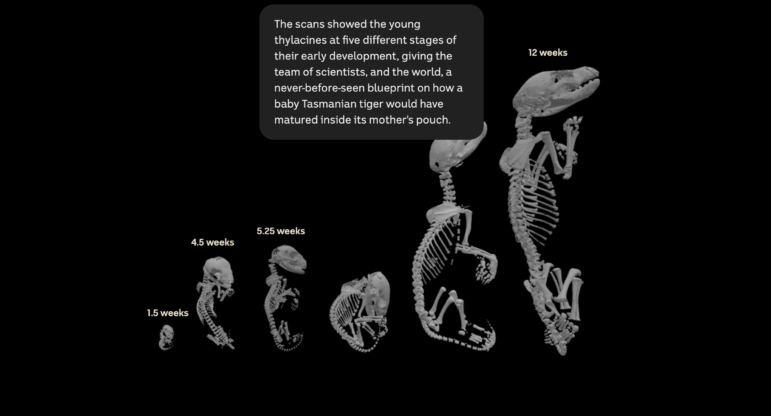
Image: Screenshot, ABC Australia
It was a rare and historic opportunity: scientists in Melbourne had been granted access to 13 of the youngest preserved Tasmanian tigers — a meat-eating marsupial driven into extinction by European colonizers. Usually off-limits to research due to the invasive techniques of dissecting these extremely rare specimens, researchers used advanced CT scanning technology to explore the internal anatomy non-invasively. Using 3D modeling, ABC’s Digital Story Innovation team took readers on a journey into natural history, revealing the vital organs and intricate bodily systems of these animals. The scans captured the thylacines at early developmental stages, offering scientists a unique look into how they grew inside their mother’s pouch. The scans also uncovered a surprising twist: two of the specimens analyzed were not Tasmanian tigers at all, reducing the confirmed number of preserved Tasmanian tigers from 13 to 11 — a discovery that “wiped millions of dollars off the value of the Tasmanian Museum and Art Gallery’s collection.“
Top Headlines Throughout Singapore’s History
Singapore’s Straits Times has conducted an ambitious analysis of 180 years of front-page headlines, beginning with its inaugural issue on July 15, 1845. Using an algorithm to assess the prominence of certain topics each year, journalists assigned weighted scores based on the frequency of key terms, revealing which subjects dominated public discourse over time. Readers can explore an interactive streamgraph that visualizes these findings, highlighting major news events that drove spikes in certain topics. An interactive calendar also allows users to browse historical front pages by date, offering a glimpse into Singapore’s past through the eyes of its national newspaper. The topics are organized into nine major themes, ranging from epidemics to foreign affairs, with the data showing how the prominence of each has shifted over time. For instance, the algorithm ranks COVID-19 coverage as dramatically surpassing that of previous outbreaks like SARS or dengue, underscoring the pandemic’s unprecedented impact on headlines.
Pro-Russian Bots Target Ukraine’s Occupied Territories On Telegram
Telegram is at the epicenter of pro-Russian narratives being pushed by bots, according to a joint investigation by OpenMinds and the Digital Forensic Research Lab (DFRLab). Analyzing more than 3,600 automated pro-Russian accounts that targeted people living in the Russian-occupied Ukrainian territories between January 2024 and April 2025, the investigation identified three overarching themes: pro-Russian propaganda, anti-Ukrainian propaganda, and “abstract” anti-war messaging. Researchers used the Telegram API to collect a total analyzed dataset of 3.37 million Telegram comments, identifying over 316,000 comments from bot-like accounts spreading coordinated messages. Using AI tools and manual review, they classified whether the messages promoted pro-Russian propaganda, revealing how bots are used to shape public opinion in coordinated messaging on the platform.
Bonus: What Is the Relative Cost of a Visa to Europe Around the World?
LAGO Collective, a research organization focusing on migration, teamed up with data visualization designer Federica Fragapane to look at the cost of visa application fees and the financial burden on people from different countries. A $100 fee — which is typically the cost of a short-term visa to Europe — means vastly different things for someone in Nigeria or Pakistan versus someone in Germany. Using datasets from Our World in Data on food expenditure and daily income per capita, the team calculated how long it would take to earn $100 and how much it can buy in groceries, highlighting the “lived cost of a visa application” to reveal visa inequality.
Hanna Duggal is a data journalist at AJ Labs, the data, visual storytelling, and experiments team of Al Jazeera and a GIJN contributor. She has reported on issues such as policing, surveillance, and protests using data, and reported for GIJN on data journalism in the Middle East, investigating algorithms onTikTok, and on using data to investigate tribal lands in the US.

